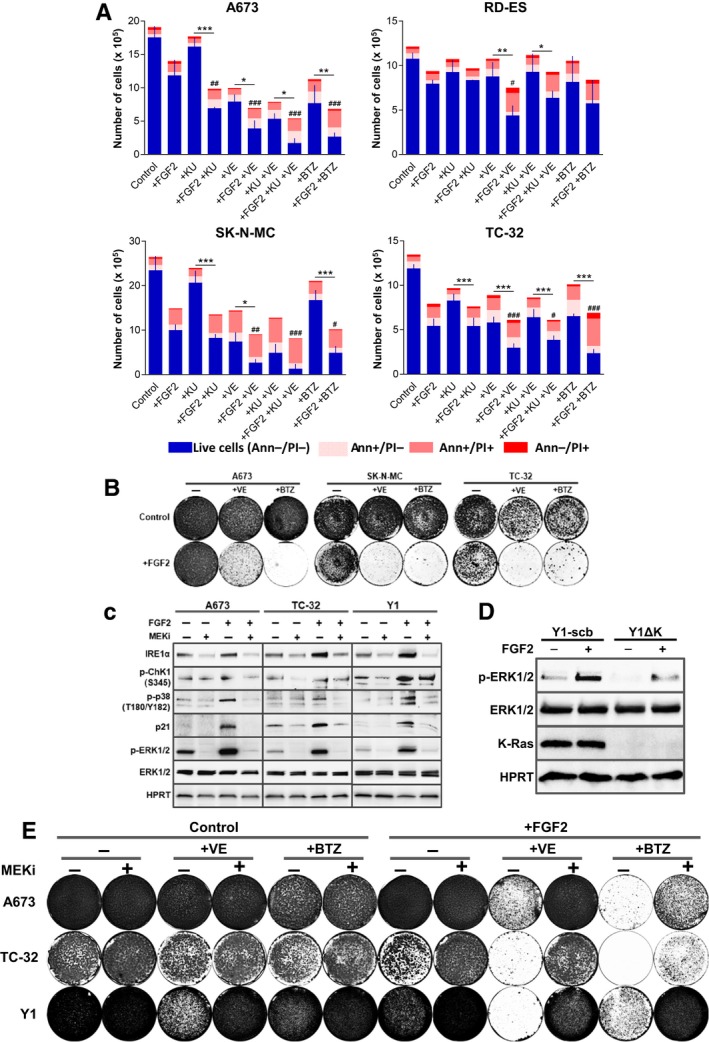Figure 5.

FGF2 promotes MAPK‐ERK1/2 sustained overactivation and lethally sensitizes human cancer cells to checkpoint and proteasome inhibition. (A) Flow cytometry data of ESFT cells growing in complete media in presence or absence of FGF2 for 72 h, with concomitant addition of KU‐55933 (+KU), VE‐821 (+VE), both (+KU +VE), or addition of bortezomib (+BTZ) in the last 48 h. Concentrations as follows: A673 cells FGF2 20 ng·mL−1, KU 5 μm, VE 5 μm, and BTZ 10 nm; 1 × 105 cells were plated. RD‐ES cells FGF2 20 ng·mL−1, KU 5 μm, VE 5 μm, and BTZ 10 nm; 2.5 × 105 cells were plated. SK‐N‐MC cells FGF2 1 ng·mL−1, KU 5 μm, VE 2 μm, and BTZ 10 nm; 2.5 × 105 cells were plated. TC‐32 cells FGF2 5 ng·mL−1, KU 5 μm, VE 2 μm, and BTZ 10 nm; 1.5 × 105 cells were plated. Annexin V/PI double stain was used to address cell death. Results are expressed in absolute numbers of cells per plate 72 h after stimulation. Error bars indicate mean ± SD of live cells (n = 3, from independent experiments). Asterisks indicate statistically significant differences. *P < 0.05, **P < 0.01 and ***P ≤ 0.001 (one‐way ANOVA of variance followed by multiple comparison post‐test). #Significant differences from FGF2‐treated sample. # P < 0.05, ## P < 0.01 and ### P ≤ 0.001. (B) Representative assays comparing the long‐term viability of A673, TC‐32, and SK‐N‐MC cells treated with the combinations of FGF2 and VE‐821 or bortezomib. Cells were plated and treated as described in (A). After the treatments, the stimuli were washed out, the plates were grown in complete media for additional 10 days, and then fixed/stained. (C) Western blots comparing the levels of phospho‐ERK1/2 (p‐ERK1/2) and the stress markers IRE1α, phosphorylated Chk1 (p‐Chk1), phosphorylated p38 MAPK (p‐p38), and p21 in A673, TC‐32, and Y1 cells in presence or absence of FGF2 and the MEK inhibitor selumetinib. FGF2 (+) (20 ng·mL−1 for A673; 5 ng·mL−1 for TC‐32 and 10 ng·mL−1 for Y1 cells) was added to cells growing at complete media and 5 μm selumetinib was added to the indicated plates (MEKi +) 8 h after FGF2 addition. Plates were harvested 24 h after FGF2 addition. Total ERK and HPRT were used as loading controls. (D) Western blots comparing the levels of phospho‐ERK1/2 (p‐ERK1/2) and K‐Ras expression among Y1‐scb and Y1ΔK cells in the presence or absence of FGF2. FGF2 (+) (10 ng·mL−1) was added to cells growing at complete media and plates were harvested 24 h later. Total ERK and actin were used as loading controls. (E) Representative assays comparing the long‐term viability of A673, TC‐32, and Y1 cells treated with the combinations of FGF2 and VE‐821 or bortezomib, with or without the addition of the MEK inhibitor selumetinib. Cells were plated and treated as described in (A). Eight hour after FGF2 stimulation, 5 μm of selumetinib (MEKi +) was added to the indicated plates. Seventy‐two hour after FGF2 addition, the stimuli were washed out, the plates were grown in complete media for additional 10 days, and then fixed/stained.
